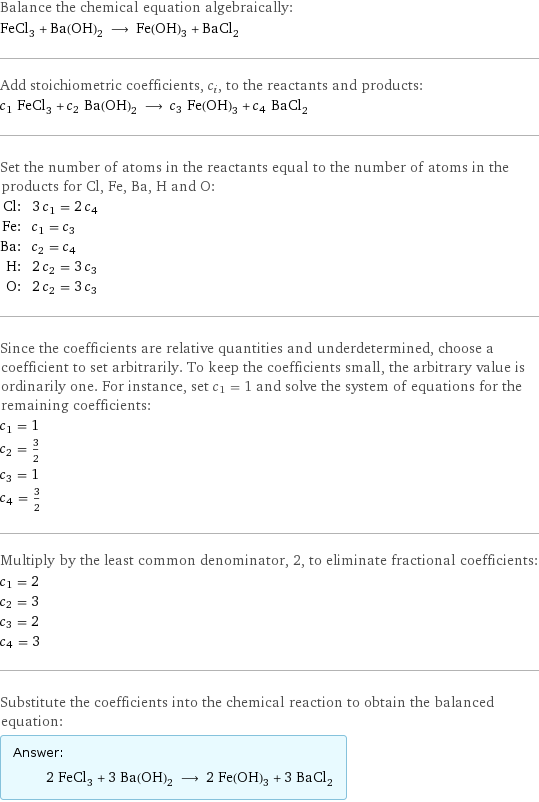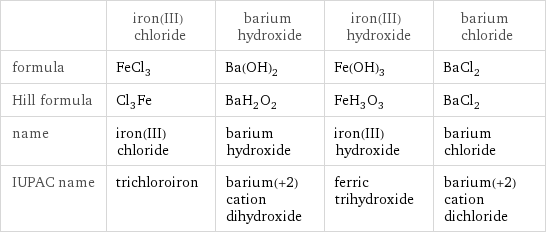Input interpretation

FeCl_3 iron(III) chloride + Ba(OH)_2 barium hydroxide ⟶ Fe(OH)_3 iron(III) hydroxide + BaCl_2 barium chloride
Balanced equation

Balance the chemical equation algebraically: FeCl_3 + Ba(OH)_2 ⟶ Fe(OH)_3 + BaCl_2 Add stoichiometric coefficients, c_i, to the reactants and products: c_1 FeCl_3 + c_2 Ba(OH)_2 ⟶ c_3 Fe(OH)_3 + c_4 BaCl_2 Set the number of atoms in the reactants equal to the number of atoms in the products for Cl, Fe, Ba, H and O: Cl: | 3 c_1 = 2 c_4 Fe: | c_1 = c_3 Ba: | c_2 = c_4 H: | 2 c_2 = 3 c_3 O: | 2 c_2 = 3 c_3 Since the coefficients are relative quantities and underdetermined, choose a coefficient to set arbitrarily. To keep the coefficients small, the arbitrary value is ordinarily one. For instance, set c_1 = 1 and solve the system of equations for the remaining coefficients: c_1 = 1 c_2 = 3/2 c_3 = 1 c_4 = 3/2 Multiply by the least common denominator, 2, to eliminate fractional coefficients: c_1 = 2 c_2 = 3 c_3 = 2 c_4 = 3 Substitute the coefficients into the chemical reaction to obtain the balanced equation: Answer: | | 2 FeCl_3 + 3 Ba(OH)_2 ⟶ 2 Fe(OH)_3 + 3 BaCl_2
Structures

+ ⟶ +
Names

iron(III) chloride + barium hydroxide ⟶ iron(III) hydroxide + barium chloride
Equilibrium constant
![Construct the equilibrium constant, K, expression for: FeCl_3 + Ba(OH)_2 ⟶ Fe(OH)_3 + BaCl_2 Plan: • Balance the chemical equation. • Determine the stoichiometric numbers. • Assemble the activity expression for each chemical species. • Use the activity expressions to build the equilibrium constant expression. Write the balanced chemical equation: 2 FeCl_3 + 3 Ba(OH)_2 ⟶ 2 Fe(OH)_3 + 3 BaCl_2 Assign stoichiometric numbers, ν_i, using the stoichiometric coefficients, c_i, from the balanced chemical equation in the following manner: ν_i = -c_i for reactants and ν_i = c_i for products: chemical species | c_i | ν_i FeCl_3 | 2 | -2 Ba(OH)_2 | 3 | -3 Fe(OH)_3 | 2 | 2 BaCl_2 | 3 | 3 Assemble the activity expressions accounting for the state of matter and ν_i: chemical species | c_i | ν_i | activity expression FeCl_3 | 2 | -2 | ([FeCl3])^(-2) Ba(OH)_2 | 3 | -3 | ([Ba(OH)2])^(-3) Fe(OH)_3 | 2 | 2 | ([Fe(OH)3])^2 BaCl_2 | 3 | 3 | ([BaCl2])^3 The equilibrium constant symbol in the concentration basis is: K_c Mulitply the activity expressions to arrive at the K_c expression: Answer: | | K_c = ([FeCl3])^(-2) ([Ba(OH)2])^(-3) ([Fe(OH)3])^2 ([BaCl2])^3 = (([Fe(OH)3])^2 ([BaCl2])^3)/(([FeCl3])^2 ([Ba(OH)2])^3)](../image_source/f43c7d0cf27a3821d258ad26bb360f9d.png)
Construct the equilibrium constant, K, expression for: FeCl_3 + Ba(OH)_2 ⟶ Fe(OH)_3 + BaCl_2 Plan: • Balance the chemical equation. • Determine the stoichiometric numbers. • Assemble the activity expression for each chemical species. • Use the activity expressions to build the equilibrium constant expression. Write the balanced chemical equation: 2 FeCl_3 + 3 Ba(OH)_2 ⟶ 2 Fe(OH)_3 + 3 BaCl_2 Assign stoichiometric numbers, ν_i, using the stoichiometric coefficients, c_i, from the balanced chemical equation in the following manner: ν_i = -c_i for reactants and ν_i = c_i for products: chemical species | c_i | ν_i FeCl_3 | 2 | -2 Ba(OH)_2 | 3 | -3 Fe(OH)_3 | 2 | 2 BaCl_2 | 3 | 3 Assemble the activity expressions accounting for the state of matter and ν_i: chemical species | c_i | ν_i | activity expression FeCl_3 | 2 | -2 | ([FeCl3])^(-2) Ba(OH)_2 | 3 | -3 | ([Ba(OH)2])^(-3) Fe(OH)_3 | 2 | 2 | ([Fe(OH)3])^2 BaCl_2 | 3 | 3 | ([BaCl2])^3 The equilibrium constant symbol in the concentration basis is: K_c Mulitply the activity expressions to arrive at the K_c expression: Answer: | | K_c = ([FeCl3])^(-2) ([Ba(OH)2])^(-3) ([Fe(OH)3])^2 ([BaCl2])^3 = (([Fe(OH)3])^2 ([BaCl2])^3)/(([FeCl3])^2 ([Ba(OH)2])^3)
Rate of reaction
![Construct the rate of reaction expression for: FeCl_3 + Ba(OH)_2 ⟶ Fe(OH)_3 + BaCl_2 Plan: • Balance the chemical equation. • Determine the stoichiometric numbers. • Assemble the rate term for each chemical species. • Write the rate of reaction expression. Write the balanced chemical equation: 2 FeCl_3 + 3 Ba(OH)_2 ⟶ 2 Fe(OH)_3 + 3 BaCl_2 Assign stoichiometric numbers, ν_i, using the stoichiometric coefficients, c_i, from the balanced chemical equation in the following manner: ν_i = -c_i for reactants and ν_i = c_i for products: chemical species | c_i | ν_i FeCl_3 | 2 | -2 Ba(OH)_2 | 3 | -3 Fe(OH)_3 | 2 | 2 BaCl_2 | 3 | 3 The rate term for each chemical species, B_i, is 1/ν_i(Δ[B_i])/(Δt) where [B_i] is the amount concentration and t is time: chemical species | c_i | ν_i | rate term FeCl_3 | 2 | -2 | -1/2 (Δ[FeCl3])/(Δt) Ba(OH)_2 | 3 | -3 | -1/3 (Δ[Ba(OH)2])/(Δt) Fe(OH)_3 | 2 | 2 | 1/2 (Δ[Fe(OH)3])/(Δt) BaCl_2 | 3 | 3 | 1/3 (Δ[BaCl2])/(Δt) (for infinitesimal rate of change, replace Δ with d) Set the rate terms equal to each other to arrive at the rate expression: Answer: | | rate = -1/2 (Δ[FeCl3])/(Δt) = -1/3 (Δ[Ba(OH)2])/(Δt) = 1/2 (Δ[Fe(OH)3])/(Δt) = 1/3 (Δ[BaCl2])/(Δt) (assuming constant volume and no accumulation of intermediates or side products)](../image_source/501a138fbbcf4729d592fd67b49550cd.png)
Construct the rate of reaction expression for: FeCl_3 + Ba(OH)_2 ⟶ Fe(OH)_3 + BaCl_2 Plan: • Balance the chemical equation. • Determine the stoichiometric numbers. • Assemble the rate term for each chemical species. • Write the rate of reaction expression. Write the balanced chemical equation: 2 FeCl_3 + 3 Ba(OH)_2 ⟶ 2 Fe(OH)_3 + 3 BaCl_2 Assign stoichiometric numbers, ν_i, using the stoichiometric coefficients, c_i, from the balanced chemical equation in the following manner: ν_i = -c_i for reactants and ν_i = c_i for products: chemical species | c_i | ν_i FeCl_3 | 2 | -2 Ba(OH)_2 | 3 | -3 Fe(OH)_3 | 2 | 2 BaCl_2 | 3 | 3 The rate term for each chemical species, B_i, is 1/ν_i(Δ[B_i])/(Δt) where [B_i] is the amount concentration and t is time: chemical species | c_i | ν_i | rate term FeCl_3 | 2 | -2 | -1/2 (Δ[FeCl3])/(Δt) Ba(OH)_2 | 3 | -3 | -1/3 (Δ[Ba(OH)2])/(Δt) Fe(OH)_3 | 2 | 2 | 1/2 (Δ[Fe(OH)3])/(Δt) BaCl_2 | 3 | 3 | 1/3 (Δ[BaCl2])/(Δt) (for infinitesimal rate of change, replace Δ with d) Set the rate terms equal to each other to arrive at the rate expression: Answer: | | rate = -1/2 (Δ[FeCl3])/(Δt) = -1/3 (Δ[Ba(OH)2])/(Δt) = 1/2 (Δ[Fe(OH)3])/(Δt) = 1/3 (Δ[BaCl2])/(Δt) (assuming constant volume and no accumulation of intermediates or side products)
Chemical names and formulas

| iron(III) chloride | barium hydroxide | iron(III) hydroxide | barium chloride formula | FeCl_3 | Ba(OH)_2 | Fe(OH)_3 | BaCl_2 Hill formula | Cl_3Fe | BaH_2O_2 | FeH_3O_3 | BaCl_2 name | iron(III) chloride | barium hydroxide | iron(III) hydroxide | barium chloride IUPAC name | trichloroiron | barium(+2) cation dihydroxide | ferric trihydroxide | barium(+2) cation dichloride
Substance properties

| iron(III) chloride | barium hydroxide | iron(III) hydroxide | barium chloride molar mass | 162.2 g/mol | 171.34 g/mol | 106.87 g/mol | 208.2 g/mol phase | solid (at STP) | solid (at STP) | | solid (at STP) melting point | 304 °C | 300 °C | | 963 °C density | | 2.2 g/cm^3 | | 3.856 g/cm^3 odor | | | | odorless
Units
